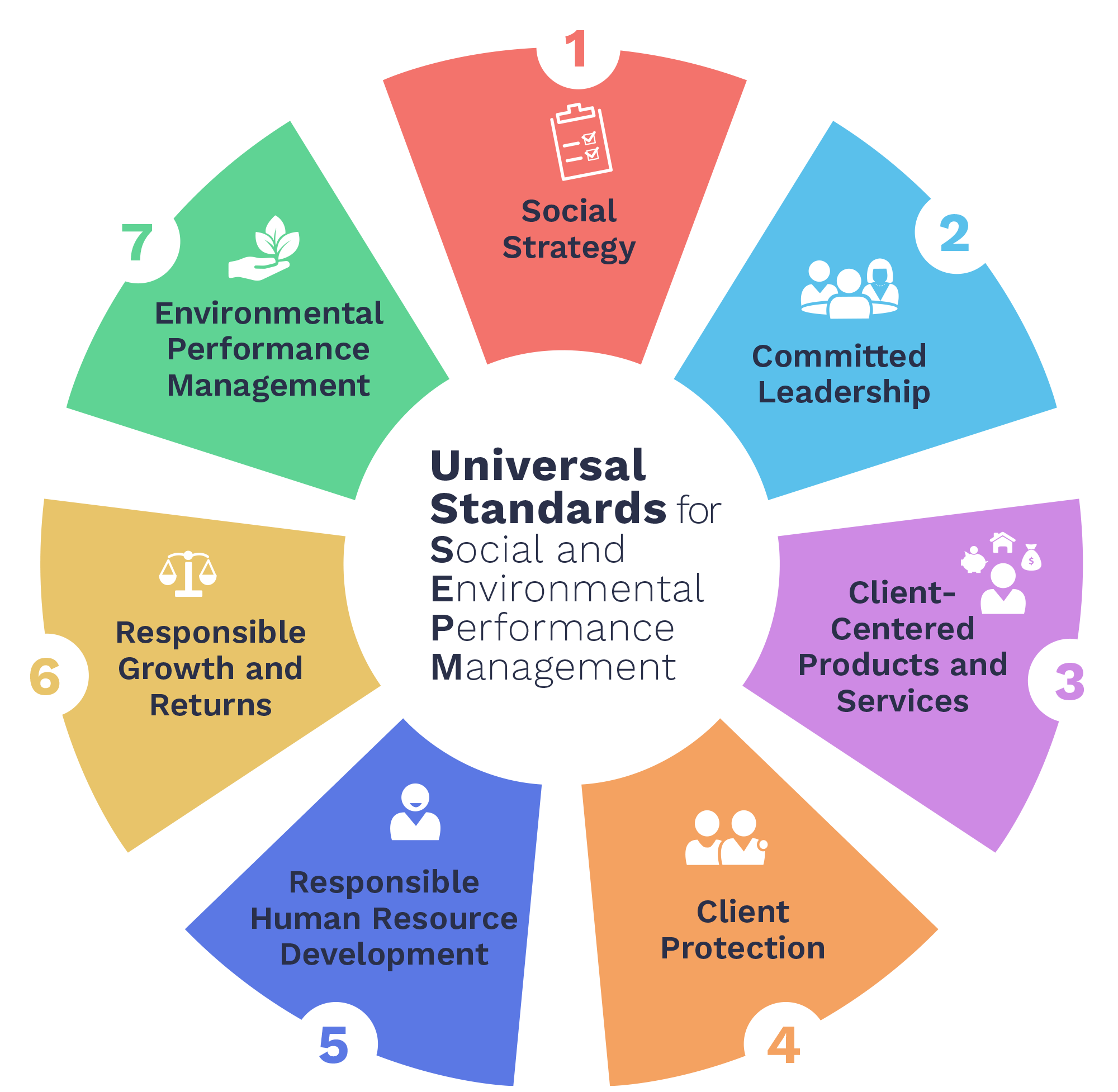The Universal Standards for Social and Environmental Performance Management (“the Universal Standards”) is a comprehensive manual of best practices. They help financial service providers put clients and the environment at the center of all strategic and operational decisions, and they show financial service providers how to align their policies and procedures with responsible business practices.
The Universal Standards were developed, tested, refined, and finalized by financial service providers all over the world, so they are highly practical. They do not just describe a vision or set forth high-level principles. Instead, the Universal Standards provide a clear roadmap that financial service providers can follow to achieve their goals. First launched in 2012 and now in their third edition, the Universal Standards have stood the test of time and proven relevant in many different geographic contexts, for many different institutional types.
The Universal Standards cover seven different dimensions of a financial institution’s operations—strategy, governance, client-centric product design, client protection, responsible human resource development, responsible growth and profits, and environmental performance management.

Financial service providers should engage with social and environmental performance management at their own pace and according to their own priorities. There is no one place to begin. Typically, a financial institution will focus on the dimension(s) where they believe they have the greatest need, or where they have an opportunity for “quick wins,” meaning positive outcomes created by relatively simple and inexpensive changes.
Whether you are interested in one dimension, or a few, or all of them, the social and environmental performance journey follows four basic steps.

LEARN
You have already started this step just by visiting this page. You can learn even more by downloading the Universal Standards and exploring the related items in our Resource Center or following our online trainings [link]. Feel free also to sign up for our newsletter, which has frequent features on real-world experiences with the Universal Standards, and contact us with any specific question or request you may have.
ASSESS
Use the SPI Online social audit tools to evaluate your organization’s strengths and weaknesses regarding its overall social and environmental performance management (SEPM). The SPI Online tools are free and fully aligned to the Universal Standards.
By design, the SPI5 Full audit tool offers a comprehensive assessment that includes every aspect of SEPM. This will help you understand deeply what SEPM is all about. It is not unusual to feel overwhelmed by the results of this assessment—but don’t be. Once you have used the tool to identify your relative strengths and weaknesses, it is perfectly reasonable to focus on improving just a few areas at a time. Each provider can set their own priorities and a realistic pace.
You may also opt to use one of the lighter versions of the tool.
IMPROVE
Many resources are available to help providers put the Universal Standards into action. SPTF’s Universal Standards Implementation Guide contains guidance on how to implement each of the Essential Practices contained in the Universal Standards. It also contains links to other useful industry resources. The SEPM Resource Center, which is organized around the Universal Standards, provides descriptions of, and links to, dozens of case studies, templates, tools, videos, and guidelines. If you need financial assistance to put your plans into action, apply to the Responsible Inclusive Finance (RIF) facilities in Africa, Southeast Asia, or the Caribbean/Central America.
During this step, it is important to remember to be realistic! When SEPM implementation fails, it is often because the provider tries to do too much, too fast. Set a budget and create an action plan, specifying the timeline for each step of the implementation process and which employees are responsible for specific deliverables. Revisit your action plan periodically and make adjustments as needed.
SHOW
There are many ways to demonstrate the results of your SEPM practices, to both internal and external stakeholders:
- The SPI social audit tool includes a reporting function that allows you to document both your SPM practices and social outcomes. Many providers are creating SPM dashboard reports using the graphs generated by the SPI4. The SEPM Resource Center has examples of SEPM dashboards.
- You can demonstrate achievement in client protection specifically by joining the Client Protection Pathway and moving along it.
- You can commission a social rating, which can include an evaluation of client outcomes. Social rates help providers demonstrate outcomes to external stakeholders such as funders.
- You can collect and report data on client outcomes. To learn more about outcomes management, visit Cerise+SPTF’s outcomes working group page.

